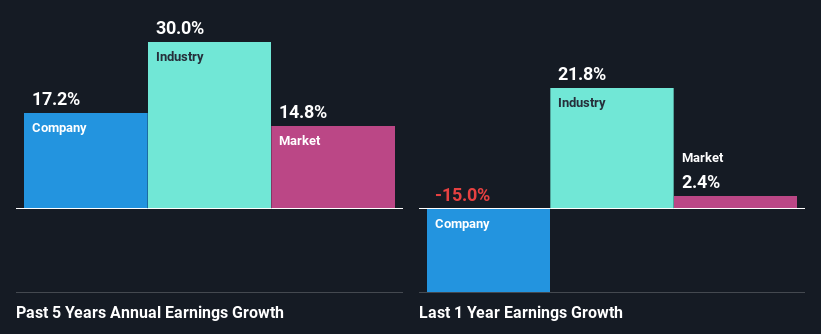Declining Stock and Decent Financials: Is The Market Wrong About BE Semiconductor Industries N.V. (AMS:BESI)?
It is hard to get excited after looking at BE Semiconductor Industries' (AMS:BESI) recent performance, when its stock has declined 15% over the past three months. However, stock prices are usually driven by a company’s financials over the long term, which in this case look pretty respectable. In this article, we decided to focus on BE Semiconductor Industries' ROE.
Return on Equity or ROE is a test of how effectively a company is growing its value and managing investors’ money. In other words, it is a profitability ratio which measures the rate of return on the capital provided by the company's shareholders.
See our latest analysis for BE Semiconductor Industries
How Do You Calculate Return On Equity?
ROE can be calculated by using the formula:
Return on Equity = Net Profit (from continuing operations) ÷ Shareholders' Equity
So, based on the above formula, the ROE for BE Semiconductor Industries is:
37% = €177m ÷ €480m (Based on the trailing twelve months to March 2024).
The 'return' is the profit over the last twelve months. One way to conceptualize this is that for each €1 of shareholders' capital it has, the company made €0.37 in profit.
What Has ROE Got To Do With Earnings Growth?
We have already established that ROE serves as an efficient profit-generating gauge for a company's future earnings. Depending on how much of these profits the company reinvests or "retains", and how effectively it does so, we are then able to assess a company’s earnings growth potential. Assuming all else is equal, companies that have both a higher return on equity and higher profit retention are usually the ones that have a higher growth rate when compared to companies that don't have the same features.
A Side By Side comparison of BE Semiconductor Industries' Earnings Growth And 37% ROE
Firstly, we acknowledge that BE Semiconductor Industries has a significantly high ROE. Additionally, the company's ROE is higher compared to the industry average of 15% which is quite remarkable. This likely paved the way for the modest 17% net income growth seen by BE Semiconductor Industries over the past five years.
As a next step, we compared BE Semiconductor Industries' net income growth with the industry and were disappointed to see that the company's growth is lower than the industry average growth of 30% in the same period.
The basis for attaching value to a company is, to a great extent, tied to its earnings growth. It’s important for an investor to know whether the market has priced in the company's expected earnings growth (or decline). This then helps them determine if the stock is placed for a bright or bleak future. If you're wondering about BE Semiconductor Industries''s valuation, check out this gauge of its price-to-earnings ratio, as compared to its industry.
Is BE Semiconductor Industries Making Efficient Use Of Its Profits?
While BE Semiconductor Industries has a three-year median payout ratio of 92% (which means it retains 8.0% of profits), the company has still seen a fair bit of earnings growth in the past, meaning that its high payout ratio hasn't hampered its ability to grow.
Additionally, BE Semiconductor Industries has paid dividends over a period of at least ten years which means that the company is pretty serious about sharing its profits with shareholders. Based on the latest analysts' estimates, we found that the company's future payout ratio over the next three years is expected to hold steady at 78%. Regardless, the future ROE for BE Semiconductor Industries is predicted to rise to 70% despite there being not much change expected in its payout ratio.
Summary
Overall, we feel that BE Semiconductor Industries certainly does have some positive factors to consider. Its earnings have grown respectably as we saw earlier, probably due to its high returns. However, it does reinvest little to almost none of its profits, so we wonder what effect this could have on its future growth prospects. With that said, the latest industry analyst forecasts reveal that the company's earnings are expected to accelerate. To know more about the latest analysts predictions for the company, check out this visualization of analyst forecasts for the company.
Have feedback on this article? Concerned about the content? Get in touch with us directly. Alternatively, email editorial-team (at) simplywallst.com.
This article by Simply Wall St is general in nature. We provide commentary based on historical data and analyst forecasts only using an unbiased methodology and our articles are not intended to be financial advice. It does not constitute a recommendation to buy or sell any stock, and does not take account of your objectives, or your financial situation. We aim to bring you long-term focused analysis driven by fundamental data. Note that our analysis may not factor in the latest price-sensitive company announcements or qualitative material. Simply Wall St has no position in any stocks mentioned.

 Yahoo Finance
Yahoo Finance 
